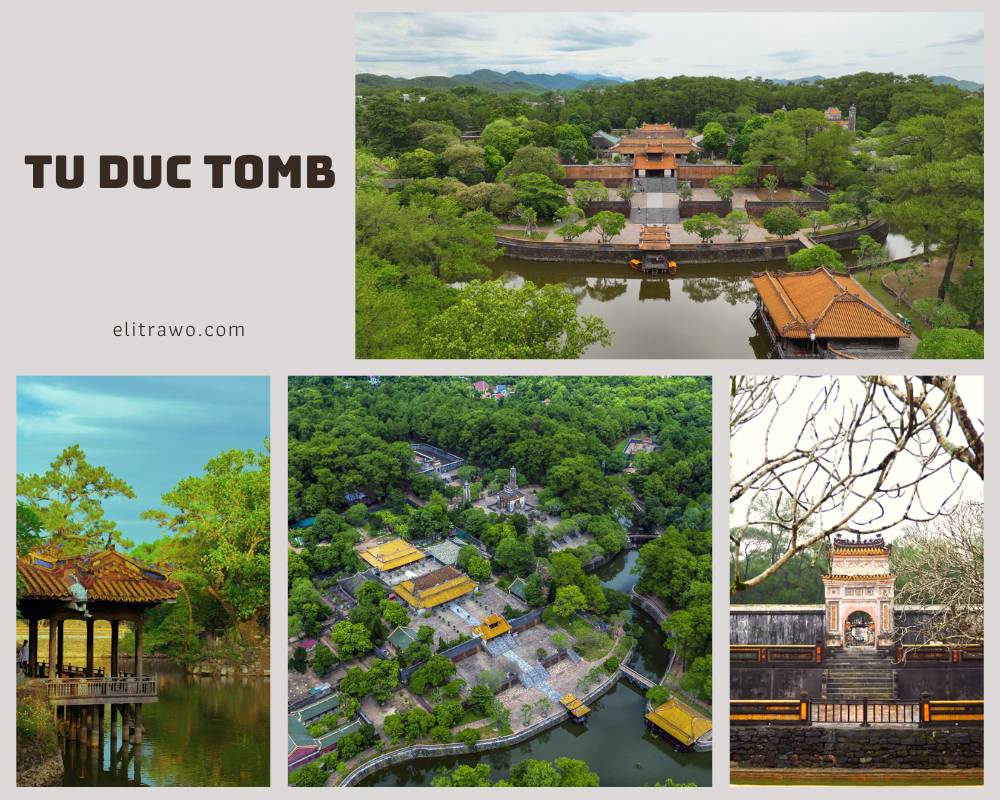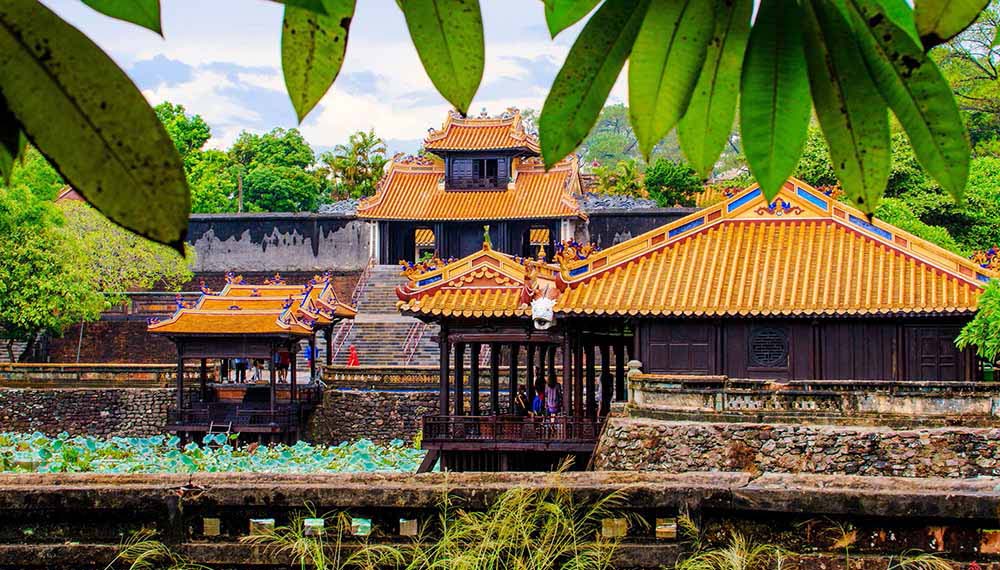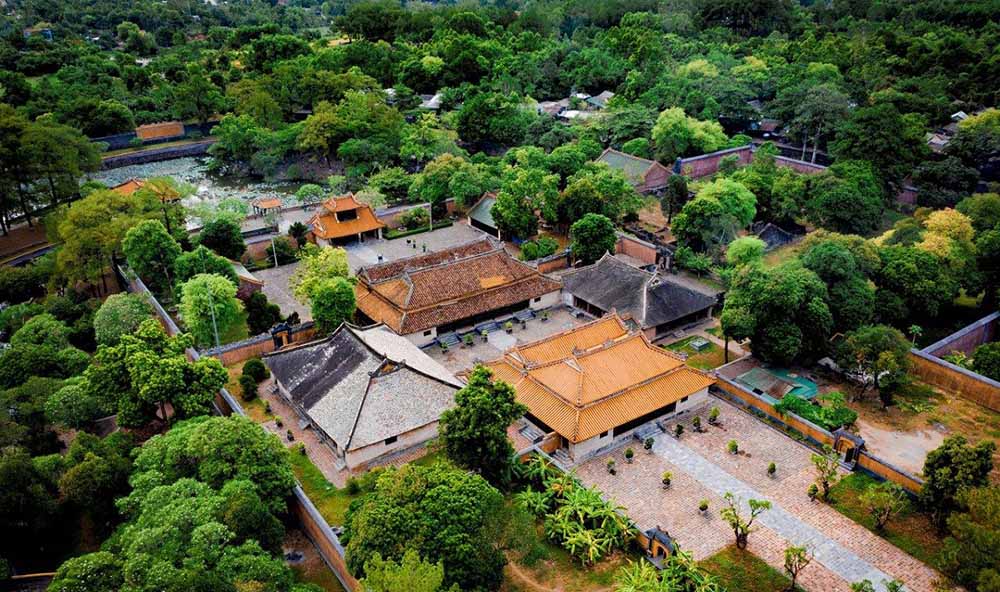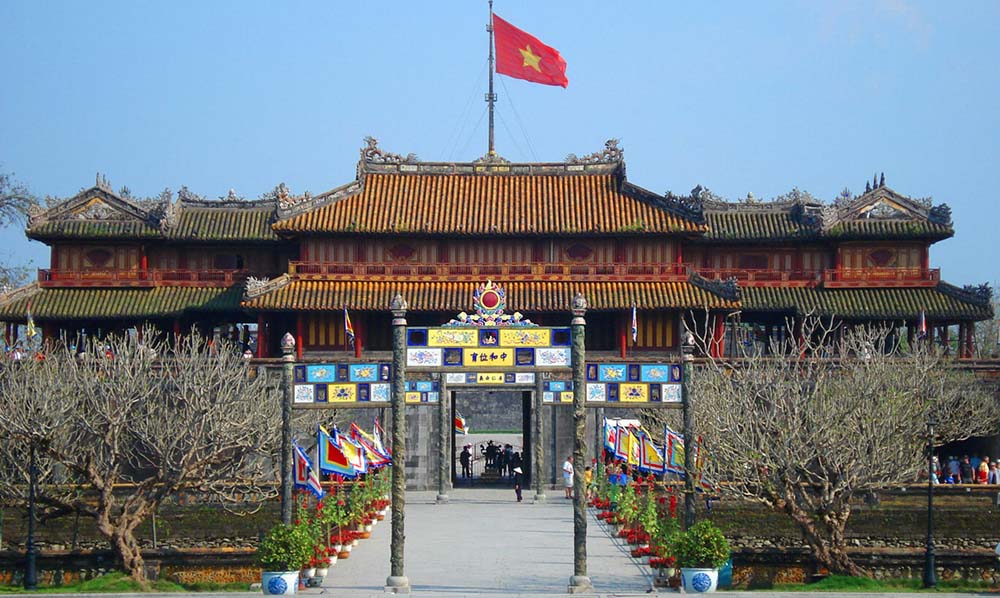Explore the majestic Tu Duc Tomb in Hue, Vietnam. This imperial mausoleum showcases stunning architecture and tranquil gardens.
Learn about Emperor Tu Duc's life, the tomb's unique features, and its historical significance in Vietnamese culture.
List of Contents
1. Overview of Tu Duc Tomb

1.1 Location and Accessibility
Located just 8 kilometers from Hue's city center, Tu Duc Tomb is a convenient and fascinating destination for a day trip. Visitors can easily explore the tomb's vast grounds and intricate structures, immersing themselves in the rich history of the Nguyen Dynasty.
Key information:
- Address: 17/69 Le Ngo Cat Street, Thuy Xuan Ward, Hue City, Thua Thien Hue Province
- Distance from city center: 8 kilometers
- Opening hours: 7:30 am to 5:30 pm daily
- Entrance fees:
- Adults: 150,000 VND
- Children: 30,000 VND
1.2 History of The Tu Duc Tomb

Tomb The Tu Duc Tomb, a testament to Emperor Tu Duc's 36-year reign, was built between 1864 and 1873. The emperor, known for his poetry and scholarly pursuits, oversaw the tomb's construction, which covers 20 hectares and includes 50 structures within its 1,500-meter-long wall.
Building the imperial tomb was not without hardship. Laborers worked long hours with little food or clothing, leading to the Chay Voi rebellion. To quell the unrest, Tu Duc renamed the tomb Khiem Cung and apologized publicly.
2. Architectural Highlights

2.1 General Layout
Spanning 12 hectares, Tu Duc's mausoleum harmoniously blends natural and man-made elements across nearly 50 structures. The recurring use of “Khiem,” meaning “modest,” reflects the emperor's philosophy and desire to be remembered as a humble ruler.
2.2 Key Structures
Luu Khiem Lake and Tinh Khiem Islet
The serene lake, once a small stream, is adorned with lotus flowers in summer. Tinh Khiem Islet, at its center, was where Tu Duc cultivated rare plants, some of which still grow.
Hoa Khiem Palace
Formerly Tu Duc's residence during visits, this palace now serves as a place of worship for the emperor and his wife, showcasing his modest lifestyle.
Luong Khiem Temple
Dedicated to Empress Dowager Tu Du, this temple houses her belongings and allows visitors to pay respects, symbolizing Tu Duc's filial piety.
Minh Khiem Ancient Theater
One of Vietnam's oldest theaters, it features intricate carvings and paintings of celestial bodies, reflecting Tu Duc's love for the arts.

The Tomb Area
- Bai Dinh: This courtyard behind the worship area has statues of mandarins, soldiers, horses, and elephants to accompany the emperor in the afterlife.
- Bi Dinh: Housing a 20-ton stone stele with 4,935 characters detailing Tu Duc's life, this pavilion holds Vietnam's largest stele, a national treasure.
- The Main Tomb Area: Surrounded by a wall with three stone terrace levels, the exact location of Tu Duc's burial within remains a mystery, adding intrigue to the imperial tomb site.
3. Cultural and Historical Significance

Tu Duc Tomb reflects the emperor's life, intellect, and tragedies. A poet and philosopher, Tu Duc's reign saw cultural contributions and national challenges. The tomb's design mirrors his romantic, melancholic nature, connecting visitors to Vietnam's past.
The imperial tomb exemplifies traditional Hue architecture, blending with the landscape. A UNESCO World Heritage Site, it's also featured in Google Arts & Culture's 3D project, allowing global virtual exploration.
4. Visiting Tu Duc Tomb
4.1 How to get to Tu Duc Tomb

Reaching Tu Duc Tomb is convenient due to its proximity to Hue's city center, approximately 6-8 kilometers away. Visitors have several transportation options:
- Motorbike: Renting a motorbike offers flexibility and the opportunity to explore the surrounding areas at your own pace. It takes about 20 minutes from the city center.
- Taxi: A comfortable and hassle-free option, taxis provide a quick route to the tomb. Reputable companies like XANH SM offer reliable services.
- Boat: For a more scenic route, taking a boat along the Perfume River combines the visit to Tu Duc Tomb with a stop at Thien Mu Pagoda. This option involves a short walk from the riverbank to the tomb.
Read more: How to Get Around in Hue
4.2 Best Time to Visit Tu Duc Tomb

The optimal time to visit Tu Duc Tomb is during the spring months, from February to May. During this period, the weather is mild and pleasant, making it ideal for exploring the extensive grounds. Visitors should be prepared for the seasonal weather:
- Spring (February to May): Mild temperatures and clear skies.
- Summer (June to August): Bring sunscreen, hats, and plenty of water to stay hydrated.
- Autumn (September to November): Light layers and a raincoat can be useful.
- Winter (December to January): Warm clothing and umbrellas are recommended.
4.3 Tips for Visitors

Given the large area of Tu Duc Tomb, comfortable attire is essential for an enjoyable visit. Here are some additional tips:
- Comfortable Clothing: Wear light and breathable fabrics, and opt for comfortable walking shoes.
- Essentials: Carry water, hats, and sunscreen to protect against the sun. During the rainy season, an umbrella or raincoat is advisable.
- Planning: Allocate enough time to fully explore the tomb's many structures and scenic spots.
5. Conclusion
Tu Duc Tomb stands as a majestic symbol of Vietnam's rich cultural heritage and history. Its intricate architecture, serene landscapes, and historical significance offer a unique glimpse into the life of Emperor Tu Duc and the Nguyen Dynasty.
Whether you're a history enthusiast, an architecture aficionado, or simply a curious traveler, Tu Duc Tomb is a destination that promises a memorable and enriching experience.
After exploring the tomb, you'll want to dive deeper into what Hue has to offer. Check out our comprehensive Hue Travel Guide for tips on the best places to eat, stay, and explore in this historic city.
Additionally, don't miss our list of Things to Do in Hue to make the most of your trip. From ancient pagodas to vibrant markets, Hue has something for every traveler.







I love your blog.. very nice colors & theme. Did you make this website yourself or did you hire someone to do it for you? Plz respond as I’m looking to design my own blog and would like to know where u got this from. many thanks